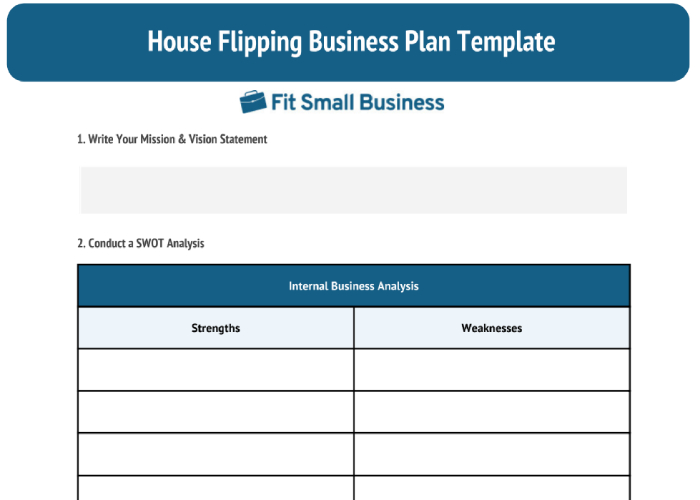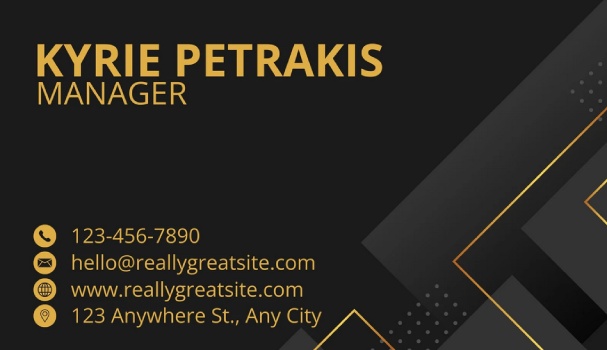Before taking any house-flipping steps, it’s crucial to lay a strong foundation. This base involves creating a comprehensive business plan encompassing operational setup, team recruitment, property evaluation, securing funds, and the flipping process. To aid in this endeavor, we offer a free template and seven critical steps on how to start a house-flipping business to help you craft a solid strategy and ensure your venture’s success.
If you landed here looking for information on where to find fix-and-flip houses, see our article, How to Find Houses to Flip for Profit in 7 Ways.
1. Prepare a Real Estate Investment Business Plan
Before taking any steps to buying and flipping houses, you need a business plan with specific strategies that pertain to the fix-and-flip business model. A business plan provides a roadmap for how many projects you’ll need to take on, how much profit you need to generate, and funding details that will keep you on track to meet your goals. A clear plan also demonstrates professionalism to lenders and investors when seeking funding.
Complete the following information to get started:
- Write mission and vision statements
- Conduct a SWOT analysis (strengths, weaknesses, opportunities, and threats)
- Set specific and measurable goals
- Write a company summary
- Conduct a market analysis
However, in addition to items from a general investment business plan, a strong house-flipping business plan includes detailed information about this unique business model. Make sure your plan also includes the following:
- Types of properties: Such as single-family homes, duplexes, or multifamily properties.
- Geographic area: The specific locations and neighborhoods where you want to invest.
- Who’ll do the work: Decide if a contractor does the work, you hire a team of specialists, or if you’re doing the work yourself.
- Project timeline: The projected timeline to complete the flip and a six-month margin for inevitable delays.
- Number of projects: How many projects you can realistically manage and complete during the course of one year.
- Financial plan and sources: Define your financing sources and include all costs such as materials, labor, carrying costs (taxes, insurance, utilities, mortgage principal and interest), marketing, and real estate agent commission.
- Expected return on investment (ROI): This figure should include actual calculations, not just a goal. It’s common for flippers to aim for an ROI of 20%. However, returns will vary depending on the location, property values, and the current real estate market conditions.
Use our free template below to write your house-flipping plan and start your business on the right foot:
2. Set Up Your House-flipping Business Operations
While many think flipping houses is solely about buying, renovating, and selling, it’s crucial to establish the proper business foundation for long-term success. This step involves choosing the correct legal entity, like an LLC, registering your business, and creating separate bank accounts. Consulting professionals, such as attorneys and accountants, ensure you set up your entity correctly. Proper business operations keep your enterprise organized, efficient, and legally compliant.
When launching your house-flipping business, selecting the appropriate legal structure and registering it with your state creates a separation between your personal and business assets—safeguarding you in case of business-related liabilities. For instance, if someone gets injured during a demolition, they can sue your company. Still, it creates a hedge from them suing you personally.
Common entity types for investing in real estate include DBA (doing business as), S Corp (subchapter or small business corporation), LLC (limited liability company), and sole proprietorship (the lowest form of legal protection). You must consult with your accountant and attorney as part of your learning how to start a house-flipping business to determine the best fit for your business since this also ties into your financial situation and varies by person.
Read our guide on How to Start a Real Estate Holding Company in 6 Steps for more details.
Apart from your legal business entity, you must register your business with the Internal Revenue Service (IRS) and get an employee identification number (EIN). An EIN identifies it as a business entity. Make sure to also check with your state and local municipality for what other business licenses and permits you may need, such as building permits, change of use, or special exceptions to zoning ordinances.
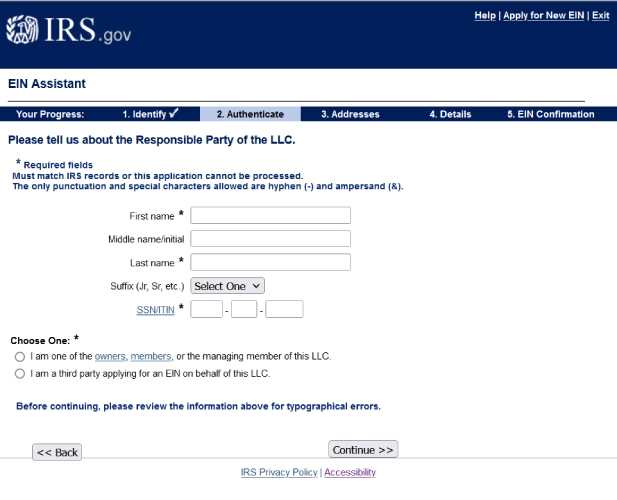
Conveniently apply online (Source: U.S. Internal Revenue Service)
With your EIN, you can open a business bank account. Keeping your personal and business money separate is essential to protecting your livelihood and staying legally compliant. Having this account up and running is crucial when starting a flipping business.
For example, you’ll be spending money on gas when looking for properties; all business expenses should come from the same account. You also need to pay your newly hired attorney and accountant. Managing your business account and costs will eliminate auditing from the IRS and complications when your accountant does your taxes.
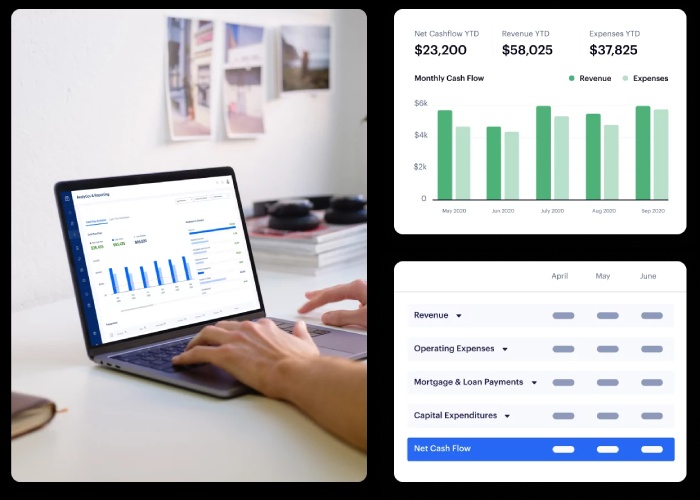
Analytics in the Baselane dashboard (Source: Baselane)
With Baselane’s analytics and reporting capabilities, gain real-time insights into your property’s performance, such as cash flow, profit and loss (P&L), capital expenditures, carrying expenses, and transfers. Streamline the consolidation of your investment property’s financial data from both your business banking and external accounts, all within a single, user-friendly platform.
Pro tip: Once your business bank account is up and running, consider applying for a business credit card—a valuable tool for acquiring building materials and office supplies without any upfront costs. Some business credit cards offer perks like cash back, which saves on your upfront costs. Some provide a 30-day to 18-month interest-free period, allowing you to manage expenses more effectively.
3. Find Financing Sources for Your House-flipping Business
A common question in house flipping is how to begin with no money. While you’ll need some funds to buy properties, many flippers don’t use cash for the entire process. They typically secure financing through hard money lenders or specialized loans for house flippers.
The two most common ways to get into the flipping homes business are:
- Hard money loans: These loans offer faster approval and funding times than traditional mortgages. The borrower qualifications are more lenient but with shorter loan terms and higher interest rates.
- Rehab loans: These include home equity lines of credit (HELOCs), HomeStyle renovation mortgages, 203(k) rehab loans, or CHOICERenovation loans. They require a lower down payment but also have more extensive criteria and paperwork.
If you have a construction or real estate background, you can join investment groups and find investors willing to put up some cash. It’s easy to find local events and groups for investors by searching on Google or Meetup.com.

Real estate investor groups (Source: Meetup)
Remember that the costs to flip a house vary depending on the individual property, its condition, prices of repairs, and the real estate market. Learning how much money you need to flip a house and how much money you can make by flipping houses can be complex. Still, getting the right financing and maximizing your profits is necessary.
Creating a budget and calculating each project is an important part of your house-flipping checklist. Use the free house-flipping calculator to generate your potential profits when shopping and evaluating potential properties.
4. Hire the Right House-flipping Professionals
When starting as a house-flipper, remember the significance of your professional network for your business plan. Flipping houses isn’t a solo venture; you’ll collaborate with experts like lawyers, accountants, real estate agents, and contractors. These professionals provide valuable insights and guidance for successful house flips, making the difference between a lucrative investment and a costly mistake.
Some important house-flipping pros to hire include:
- Real estate attorney: Manages legal aspects, ensures compliance with local laws, and drafts contracts.
- Accountant: Helps with business structure, filing house-flipping taxes, expense tracking, and financial advice.
- Real estate agent: Offers industry insights, local connections, and accurate market data.
- General contractor (GC): Oversees rehabs, ensuring quality and reducing errors.
- Administrative assistant: Assists with tasks and project management as your business grows.
- Handyperson: Handles smaller jobs, saving time and costs.
- Landscaper: Enhances curb appeal for higher ROI.
- Architect (for large projects): Ensures structural integrity and avoids costly issues.
The most trusted way to find experts is through referrals. Suppose other real estate investors or agents in your network succeeded with a professional. In that case, it’s more likely that you’ll also have a smooth experience with them. However, you should still check them out and vet them with an interview or meeting to ensure you choose the right professionals. In the long run, spending time and effort to choose an expert saves you time, money, and stress.
Pro tip: Building and utilizing your network is crucial for success in house flipping. A strong network can connect you with the right professionals, making it easier to find deals and resources. Your network provides valuable insights, market knowledge, and support from experienced individuals who can guide you through the process and help avoid common pitfalls. Additionally, networking can lead to partnerships and opportunities for collaboration, enabling you to scale your house-flipping business effectively.
5. Identify the Right Properties to Fix & Flip
Before jumping into a purchase, begin by evaluating potential properties to flip. Run a comparative market analysis (CMA) on properties or have a real estate agent run one to determine the value and calculate the return on investment (ROI). Evaluate each property within its neighborhood, location, and real estate market context.
When learning how to find houses to flip, some essential factors to evaluate include:
- Location: Pick nearby properties for easy site visits.
- Neighborhood: Choose desirable neighborhoods for curb appeal.
- Amenities: Houses near parks, schools, and other establishments attract buyers.
- Structural issues: Avoid costly structural problems.
- Value-add repairs: Research profitable upgrades like kitchens and bathrooms.
- Property size: Focus on square footage over the floor plan.
- Outdoor space: Properties with outdoor areas tend to yield higher returns.
Did you know? The potential return on investment (ROI) in a house-flipping business can be significant. Investors purchase distressed properties at a lower cost, renovate them to increase their market value, and then sell them at a higher price, resulting in a profit. ROI percentages vary widely, but successful flips can yield returns ranging from 10% to 100% or even more of the initial investment, depending on location and other factors. However, house flipping comes with risks, such as unexpected renovation costs or market fluctuations, so thorough research and proper planning are crucial to maximize ROI and minimize potential losses.
6. Create a Marketing & Lead Generation Plan
Setting up a successful house-flipping business involves some marketing and real estate branding. While a complex marketing funnel isn’t necessary initially, a well-crafted marketing strategy ensures a steady influx of new projects for your house-flipping business.
Marketing Your Fix & Flip Business
Having foundational marketing elements is crucial for projecting professionalism, building your reputation as a reliable home flipper, and marketing your newly renovated properties, especially if you seek funding. Lenders see your professionalism and experience as favorable.
Consider starting your business with these marketing elements:
As you dive into house flipping, consider expanding your marketing with tools like social media and email campaigns. Canva, a versatile and user-friendly design platform, offers templates for various needs, from social media posts to postcards and letterheads. It’s a go-to tool for business owners, making it easy to create diverse marketing materials, both digital and print.
Lead Generation Strategies for Your Business
Additionally, you will need to consistently generate potential renovation projects and motivated sellers. Many beginners use listing platforms like Zillow to find houses to flip, which offers versatile search filters to refine property searches based on your chosen criteria.
Homeowners opting to sell without agents often use FSBO.com (For Sale By Owner), Craigslist, or Facebook Marketplace. Foreclosed and bank-owned properties typically appear on websites like Foreclosure.com or the government’s HUD Homes site. These properties are appealing to investors for their potential to offer significant discounts and investment opportunities. Generate leads and learn how to find cheap houses to flip, start with the following resources:
Sites |  | |||
|---|---|---|---|---|
Best For | Investors looking for specific types of properties or features | Flippers wanting to buy deals directly from homeowners to save on agent fees | House flippers looking for deals from preforeclosures and foreclosures | Investors searching for foreclosed or bank-owned homes to buy via auction |
Key Features |
|
|
|
|
Starting Price | Free to browse | Free to browse | $39.80 per month, free 7-day trial | Free to sign up |
Learn More |
7. Buy, Rehab, Market & Sell Properties
Once you have all the right business strategies and structures in place, the bulk of your work as a house flipper comes to buying, renovating, and selling properties. As soon as you close on your property, you’ll have monthly carrying costs that can add to your planned expenses. Therefore, the more efficiently you can complete the flip, the higher your profits.
The process of making money flipping houses goes like this:
- Close on the investment property: Buying an investment property is different than purchasing a primary home, so make sure you know how to determine a budget, evaluate properties, and choose the right lender. Depending on your financing, closing on the property can take 15 to 45 days.
- Make all repairs, renovations, and upgrades: Repairing a fix-and-flip property will take the most time. You or your general contractor should manage the timeline, remembering that delays increase your carrying costs.
- Market the property for sale: There are endless ways to generate excitement about your property and increase the sale price.
- Sell the property: Working with a real estate agent is often the most efficient way for flippers to sell their properties since they manage communications with the buyer’s agent and lender and often schedule the necessary appointments. However, many flippers choose to get a real estate license to gain access to the MLS and save even more on fees.
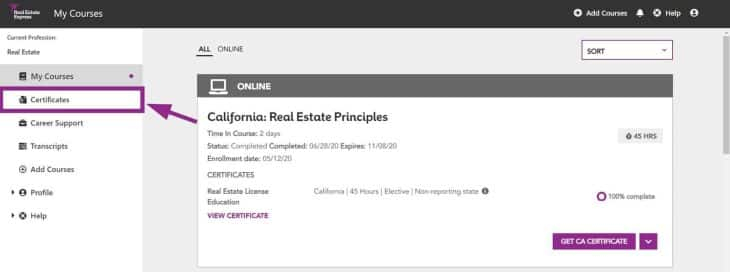
Course platform (Source: Colibri Real Estate)
Experienced house flippers often handle their property transactions to reduce expenses. You can conveniently pursue a real estate license through online schools like Colibri Real Estate, which offers comprehensive courses, instructor support, e-books, live Q&A sessions, and exam prep tools with a pass guarantee. Colibri Real Estate, an accredited education provider, has assisted countless agents and brokers nationwide in obtaining their licenses, enhancing profit opportunities.
Visit Colibri Real Estate –Use Promo Code: FSB30 for 30% off
Mistakes to Avoid When Starting a House Flipping Business
Every beginner inevitably makes mistakes while building their business. For house flippers, there are some definite learning curves, and every new project presents unique challenges. However, the more mistakes you can avoid in the beginning, the more efficiently you’ll be able to build your flipping business and generate a strong ROI.
Some mistakes to avoid when flipping houses include:
- Overestimating your abilities: Avoid taking on major electrical work or plumbing tasks if you lack the necessary skills. It can lead to costly mistakes.
- Lacking a team: House flipping often requires collaboration with contractors, real estate agents, and other professionals. Trying to do it all alone can lead to delays and errors.
- Overspending on renovations: Going over budget can eat into your profits. Plan carefully and prioritize cost-effective improvements.
- Buying a flip far away: Distance can make managing the project effectively and promptly responding to issues challenging.
- Not understanding the numbers: Accurate financial calculations are crucial. Failing to grasp costs and potential profits can result in financial setbacks.
- Being unprepared for the unexpected: House flips often encounter unexpected issues, such as hidden structural problems. Have a contingency plan and budget for surprises.
Frequently Asked Questions (FAQs)
Real estate investors use the 70% rule in house flipping to determine the maximum purchase price for a property to ensure a profitable flip. According to this rule, investors should not pay more than 70% of the property’s after-repair value (ARV) minus the estimated repair and carrying costs.
The initial capital needed for house flipping varies due to location, property type, and your specific flipping houses business plan. Generally, having access to $20,000 to $50,000 is a good starting point. This budget should encompass property purchase, renovation, carrying costs (like taxes and utilities), and contingencies for surprises. Access to financing options, such as loans or partnerships, can also affect your capital requirements.
The number of houses you can reasonably flip in a year depends on various factors, including your experience, team, resources, and local market conditions. On average, experienced house flippers may aim for two to five flips yearly. Beginners may start with one to two flips annually. Scaling beyond these numbers often requires a well-established operation, access to financing, and efficient project management.
Bottom Line
Learning how to start a house-flipping business begins with a strong business plan. It also starts by setting up the right legal and financial systems to set yourself up for success as the business grows. Successful home flippers also create a network of professionals to get their flips done properly and implement strategic marketing and lead generation systems. After following this step-by-step guide, your house-flipping business will be ready to generate strong profits.
